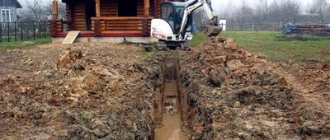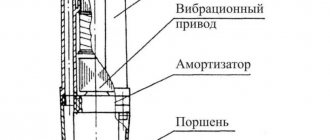Own water supply is an important condition for comfortable living in a country house
Having a well, you don’t have to worry about the constant availability of clean and fresh water, even if it is possible to get it from a centralized system. Every homeowner would prefer to connect water from a well to the in-house network, if only because it is guaranteed to be cleaner and healthier and is not turned off at the whim of the supplier.
Oil film, colored stains...
The chemical formula and physical properties do not allow oils to mix with water. And this is one of the positive aspects (so to speak) of getting them into the well - they are visible to the naked eye. There are substances in water that are more harmful than oil, but it continues to remain clean and taste normal, for example, nitrites, nitrates, radioactive elements.
As soon as contamination has occurred, a film will appear on the surface of the water, which can be easily seen in a bucket of water, or simply by shining a light into the shaft of a shallow well. It is accompanied by a specific taste and smell, so the impurity may not be noticed immediately only in a seasonal well or a completely abandoned one.
The unpleasant fact of oil ingress has been established. Not good, but not catastrophic either. The main thing is to approach the problem responsibly, and not try to solve it on your own and using folk methods. It will be necessary to clean the well and treat the walls of the shaft with special preparations.
Self-detection of contaminants
Of course, the composition of water cannot be determined by eye. But the type of fluid contamination can be determined independently. To do this, you need to take some water into a clean glass glass and look at its quality. If it is cloudy and there are foreign inclusions in it, then cleaning will definitely be required.
After this, you need to look inside the well with a flashlight. If there is plaque, dirt and unpleasant growths on its walls, this means that bacteria are actively multiplying inside. Of course, the presence of algae also indicates that urgent well water treatment is required.
Do's and Don'ts
In turmoil and frustration, the owners can complicate the situation even before the team of craftsmen arrives. The first mistake is to try to collect the oil with a bucket or pump it out with a pump. The film floats on the surface, meaning the water is partially contaminated. And when the level in the well decreases, the oil falls on the walls of the shaft, is absorbed and covers a large area.
Contact with the oil film is undesirable, especially if it is not clear what kind of pollutant got into the well. Therefore, all work must be performed with thick rubber gloves.
It is good if the trunk is lined with smooth plastic pipes, which are easier to clean, but to wash the rough surface of reinforced concrete rings, you will have to try. This will increase the time of cleaning work and increase its cost.
In wells with automated water lifting, first of all you need to check the serviceability of the pump. The equipment contains a small amount of machine oil, which can leak if it breaks down. This will help determine the cause of contamination or reduce the options for contamination of the well.
It is necessary to immediately turn off the autonomous water supply from the well. In the best case, the oil has not yet had time to cover the walls of the pipes; in the worst case, the system will have to be flushed or replaced.
How else is this water dangerous?
The well itself is a closed environment. This means that the worst viruses and bacteria can easily multiply inside. Especially if the owner of a suburban area notes that the temperature of the well water is quite high. If the rings are laid shallow and the liquid is constantly heated by the soil, this will only accelerate the development of an environment favorable to microbes.
In addition, organic components, plants, accidentally drowned small animals, insects, etc. can decompose in the well. Even dangerous E. coli is often found in wells. How deep the rings are installed will not protect you from pathogenic microflora. Of course, the deeper the water is taken, the cleaner it should be. But don’t forget about underground currents, which can bring with them thousands of bacteria.
Oil in the well - reasons
If there is a pump, then there could be a leak. It contains about a glass of oil. It is enough to cover the mirror with film. In practice, there were cases when the pump broke down at the stage of pumping the well. Therefore, if it stops working, you need to immediately turn it off and remove it before all the oil leaks out. Oil stains also appear from the installation of reinforced concrete rings for industrial use with traces of lubricants. They are cheaper, there is a temptation to save money, but you have to pay many times over.
A conventional submersible pump can cause oil to appear in the well
The worst option is an oil spill nearby and its infiltration into the aquifer. Together with groundwater, they gradually flow to greater depths. This kind of pollution is considered the most severe, practically irremovable. To obtain good drinking water, you will have to install a water treatment system or look for a replacement source. In the event of a global “oil” problem, drilling and constructing an artesian well will save the day.
According to sanitary standards, drinking water should not contain any impurities of petroleum products. Only traces of them are allowed to be found. Perceptible organoleptic indicator for humans is about 5-10 ml
Oil film does not only come from petroleum products. Fatty fractions are present in ordinary household waste, which flows into cesspools. It is quite possible that your own or a neighbor’s septic tank is leaking and the waste has reached the well. The water can bring oil if the waterproofing has not been repaired for a long time.
In wells that are used seasonally, a film on the surface of the water is formed due to the proliferation of colonies of pathogenic purulent sticks. A simple analysis at the city sanitary-epidemiological station will help to identify them and develop measures to disinfect the source. Normally there should be no bacteria in the water. The human factor does not account for much, but it is not discounted either. An oil can might have fallen into the well, or the child might have dropped something but was afraid to tell his parents.
Fatty water with an oily film can appear not only in the well, but also in the well, from where it is problematic to remove it. You have to pump the well with solutions of special sorbents. Oil gets there from equipment, lubricating pipe threads. The fatty effect is created by a high concentration of iron.
Iron
Many are confident that the iron in well water is no different from that found in berries and other natural products. Actually this is not true. For example, if a summer resident dug a well next to iron ore deposits, then the composition of his blood will not change after such regular drinking. The fact is that this component is in the liquid in inorganic form.
Gradually, iron will accumulate in the human body. This may well provoke blockage of the arteries, the development of gallstones and many other dangerous ailments. The human body is simply not able to absorb such iron. If you eat a little blackcurrant, your blood counts will immediately change. This is because in this case we are talking about healthy, organic iron.
How to remove oil film
Well cleaning is performed if the source of the problem has been identified, so as not to waste time and money. If it was a one-time hit (the pump leaked), the oil film is removed, bacteria have multiplied - pumping and disinfection, etc.
The first stage of cleaning from oil film is to collect the remaining oil using a surface pump and neutral sorbents. The oil is well absorbed by paper, dry sawdust, and polyurethane foam. On an industrial scale, special absorbing gels are used. There are interesting studies on burning out pollutants.
To clean the walls of the shaft from oil residues, you can use food grade alcohol, having first checked the effectiveness of its action. Alternatively, you can try to burn the concrete walls with fire.
Having removed the oil film as much as possible, you need to wash the walls of the well from its residues. This is done using a high pressure washer and parallel pumping. Sometimes the walls of the well need to be scrubbed manually. To completely get rid of the consequences, you will need to pump out the water and replace the bottom filter, if one was used. The soil bottom of the well needs to be cleaned to a shallow depth. Along with pumping, the seams are checked and restored.
It is strictly forbidden to use chemical detergents to remove oily stains. They dissolve fat perfectly, but they have no place in the well. Solving one problem creates several more. Surfactants are persistent and dangerous pollutants.
The professional arsenal of devices uses special oil product collectors that can collect contaminants and impurities.
Cultures of some bacteria have shown high efficiency in purification from petroleum products. This is a good breeding ground for them.
It is worth considering that oil pollution is already a global problem.
When can you drink this water?
First of all, you need to periodically submit the liquid to the laboratory. If the composition of the water meets the standards, then it is important to follow several rules for using the well in order to prevent harmful bacteria and other microorganisms from entering it. You can avoid trouble if the head of the structure is reliably protected. There should be a house above it or at least a cover.
It is recommended to use a submersible drainage pump for cleaning periodically. It helps to effectively pump out silt and debris from the bottom of the well. It is also necessary to periodically check how well the underground structure is sealed. It is worth installing a rainwater drainage system and installing filter elements at the bottom.
Efficiency of cleaning measures
The ingress of a small amount of oil and the prompt action to neutralize it provide a 100% result in cleaning the well. If possible, you should pay attention to the composition of the oil. As it passes into the aquifer, it is broken into fractions, some easier to remove, others more difficult.
A small example from life: an oil film was discovered in a well, the owner did not call a team from the company servicing the wells, but went to get advice on the Internet. A few days later the film disappeared. Science has proven that not a single substance appears from nothing and disappears into nowhere. The oil just started to disintegrate and remained in the water. Its presence can only be detected by extensive chemical testing of water samples.
After completing the cleaning and good water tests, you need to flush the water supply. Household appliances (boiler, washing machine) will have to be washed thoroughly.
see also
Comments 29
or due to bottom filter or manganese
Filter... so to speak. They threw out the shield, washed the stones, put everything back in - the water became excellent. according to the analysis there was no manganese
ICE. The neighbor had the same crap with the shield. We pumped it out, pulled the crap out, washed the rings, after filling up with water, pumped it out again and now everything is fine according to the experts’ results. I haven’t handed over my water, everything is OK for the fourth year. Ugh, ugh, ugh. . . For food, I run it through a large Korean filter with mineralization.
Oh yes, friends... I forgot to write back... we found out with 95% accuracy what happened to my well...
It turns out it's rotten. Rot coming from the aspen panel at the bottom. The so-called bottom filter. as professionals write, freshly cut sawn aspen, etc., already gives off a pungent odor, and in water, despite the supposed “impossibility” of the process, it begins to decompose... and as a result - stench, turbidity, putrefactive bacteria in the form of a black coating.
Like this. SO what about the future for those who will dig a well. Forumhouse specialists say that in their entire practice, only 5% out of a hundred have had to install this bottom filter; basically, it is useless, and simply serves as a money grab during installation, and (for unscrupulous diggers) during subsequent use, for cleaning and removing the shield
I'll put in my 5 cents :-)) Very similar to bacteria.
then why are they only in the lower layer of water and do not rise to the upper? I have the same tops and I absolutely normally use water for food
Bacteria are divided into anaerobic and aerobic. Aerobic animals live (receive energy) without access to oxygen.
Then it would smell like gasoline. At worst, solarium :)))
yes one hundred% he is rich.;) OIL KING
I have the same crap. This black coating is very slippery and smells like silt. The well is over a year old, there are 4 rings in the ground. At the same time, here’s some crap: I pumped out the well completely only 2 times over the summer. Little water is consumed. I take the water from above with a bucket - it’s a dull yellow color. Barely noticeable, but there. If you put it in a bucket and leave it for a day, there will be a reddish sediment on the walls and bottom. The taste is normal. If you swirl the water around a little, the water becomes cleaner and there is much less sediment in the bucket. But this is not the most unpleasant thing. The most unpleasant thing is that when drawing water with a pump (hanging half a meter from the bottom), for the first 10-15 minutes the water comes with a musty smell, which is not present when drawing water with a bucket, even after splashing. That's where the smell comes from, it's not clear to me at all
IN! exactly the same! And the black stuff is as you describe, and there is a smell. I won’t say anything about the rest... they didn’t try to defend it... but when I put it in a bottle in August while pumping out seemingly clear but smelly water, the mud didn’t go away within 24 hours, but the smell remained.
An additional version of the smell has appeared... tell me, didn’t it take you an hour to place a wooden disk at the bottom of the well? I have it laid and there is an assumption that it is not aspen... and it is rotting.
In general, we agreed to do chemistry and bacteria... on the 10th-11th we will take them and give samples. Well, I’ll definitely post the results
They put a shield on you most likely because you have quicksand there. Usually in these situations they are placed so that the well does not become covered with sand. They didn’t put a shield on me, but I suspect oakum. They used tow to fill the gaps between the rings when the loam began to squeeze out from there. I also thought it was rotting. Wood will not rot under water, there is no oxygen there. What kind of soil? I have 2 shovels of black soil, then loam, then sand. This is all for one and a half rings. Then came the clay mixed with stones. If the first 2 rings were buried in 4 hours, then the remaining 2 were buried for 2 days. it feels as if a roller had previously pressed this clay with small stones there. And this is all taking into account the fact that our site is in a lowland, groundwater is close, and 3 meters from the current well there is sandy quicksand (at first they started digging there, but after 1 ring the quicksand began to appear)











